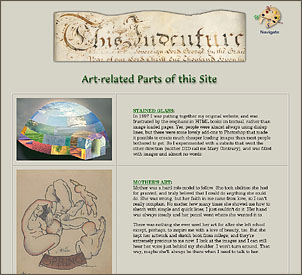Wilhelm Kray (1828-1889)
[William Kray]
The Germans have achieved some of their greatest successes in the art of figure painting with
subjects derived from that legendary lore in which their country is so rich. Among the artists
whom this world of phantoms has enchanted, probably the foremost is William Kray. he is no
stranger to the art lovers of America, for his paintings have long been popular in this country,
and are to be found in most of our prominent private collections. He was born in Berlin, and
began his studies there, afterward residing for a long time in Rome and Venice. Ultimately he
returned to Germany and ssettled in Vienna, where he speedily won distinction. In
"The Dance of the Will o' the Wisps" he renders a poetic version of the
old legend of the wildfires,
the gleaming spirits of marsh and fen.
To arrive at a just and comprehensive understanding of any artist's talent, it is often
necessary to examine him in more than one example, according to the scope his fancy may take,
in the adaptation of his powers to a varied range of subjects. Consequently, when a name
reappears in these pages, the reader can refer, for general biographical information, to the
part in which it was first mentioned, as in the present case of William Kray, the initial
specimen of whose brush was presented in part II. In this example, "The Water-Nixes' Victim,"
while the material is derived from the same romantic source as the one previously given, it is
entirely different in character of subject and in treatment.
The fable of that imaginary inhabitant of the sea, the mermaid, is as old as fable itself. In
one form or another it exists throughout the world. The islanders of the Indian Ocean and the
South Sea; the Esquimaux of the North and the Patagonians of the South, as well as the coasst
and maritime nations of the civilized world, have each their special version of the tale. It was,
unquestionably, the foundation for the myths of the sirens, tritons, nereids, and the like in classic
antiquity. Science, with its usual pitiless adherence to demonstrable facts, has traced its origin
to those curious marine animals of which the seals and sea-lions are the most familiar types, but
art does not permit science to rob it of its picturesque material, and with the painters the mermaid
retains its legendary shape and attractiveness, and the world which loves pictures has no occasion to
regret the fact. It has furnished the German artist, William Kray, with a charming motive, which he
most charmingly works out in his "Idyl of the Sea." With him the mermaiden becomes a mermother, who
sports in the waves with her baby mounted on her back. The baby is altogether human in form, however,
so that the picture may safely be assumed to be founded on the old German legend of the mermaid who married
a fisherman, and bred a human family. In any way it may be interpreted, "An Idyl of the Sea" is intrinsically
a delightful work.
The Germans have a pretty legend that there is a wood-nymph who has a passion for roses,
who dwells by woodland brooks and charms mankind by the spell of the splendid flower of love.
It is this fable which Willaim Kray personifies in "Nymph of Roses," in his usual ideal manner.
The "Undine" of William Kray is a subject whose suggestion is derived by the artist from the well-known
tale of the water-fairy. It was first exhibited at the Munich Exposition of 1879, and added much to the
artist's reputation.
The legend of Lorelei, the siren of the Rhine, is one of those which the Germans adopted from
classical antiquity and adapted to local surrounding and circumstances. William Kray represesents
the lovely and loveless enchantress seated on the craggy summit of the cliff, which is nearly five
hundred feet above the level of the stream, bathed in the beams of the moon, and by her alluring
glances inviting the hapless boatmen to their destruction.
"The Fisher" by William Kray is one of his pictures founded on the legend of the Rhine.
This tale recites how a fisherman once inspired a water sprite with such a love for him
that she could not overcome it. In order to secure possession of him, she came, while
he was fishing, up on the bank of the river and held him in such thraldom by her charms
that he did not notice the rising of the tide until it was too late, when the waters engulfed
him and his temptress carried him away to her cavern deep under the waves.
William Kray illustrates another page of the Rhine legends by his "Lorelei and Igorne."
One of the well-known pictures of William Kray, suggested by his long residence in Venice, is
"The Venetian Swimming School."
Previous Artist Next Artist






![]() Copyright © 2007, Mary S. Van Deusen
Copyright © 2007, Mary S. Van Deusen